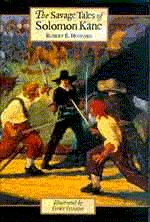
by Matthew Baugh (adapted from Richard Toogood)

There are several excellent biographical articles on Solomon Kane, the best known of which was written by Fred Blosser. I have chosen to go with Richard Toogood's version though, in the belief that it eliminated several of the chronological problems in Blosser's account. By Blosser's timeline, Kane would have been in his sixties during his African adventures. Toogood's scheme puts him in his forties, an age that fits much better with the action of the stories. This chronology constitutes what I was able to glean from Richard Toogood's excellent article. I want to stress that this is not my work, only an adaptation of his.
The majority of the information here comes from
Robert E. Howard’s stories and poems about Kane but two of the entries are
based on the writings of Italian author and REH fan Gianluigi Zuddas.
The stories, “L’Isola del Serpente Plumato” and “La Corona di Asa”
appear to be Mr. Zuddas’ attempt to make a frame for the stories by writing
the Puritan’s first and last adventures.
Mr. Zuddas also wrote his own endings to the unfinished adventures,
“The Castle of the Devil”, “Hawk of Bashti”, and “The Children of
Asshur”. All of these were
collected in the Italian volume, “Solomon Kane”, Rome, Fanucci, 1979.
1549
Solomon Kane is born to a prosperous Puritan family in Devonshire, England.
c. 1566
Kane enters the merchant marine. During the next few years he will travel as far as Hindoostan and Cathay and rise to the rank of ship's captain.
 c. 1566
c. 1566
Kane’s first voyage to the New World involves him with an Aztec princess and a legendary monster. “L’Isola del Serpente Plumato” (“The Island of the Feathered Serpent”) by Gianluigi Zuddas. (This story is plagued with historical problems[1] and may have to be regarded as strictly fictional.)
c. 1572
Kane travels to Hispanola where he becomes a buccaneer with letters of marque against Spanish ships.
1573
Kane returns to Europe and fights for the Hugenots in the French wars of religion.
1575
Kane leaves France and has his three recorded adventures in the Black Forest: "Death's Black Riders," "The Rattle of Bones" and "The Castle of the Devil."
1576
Solomon Kane travels to the Mediterranean where he and John Silent (first encountered in "The Castle of the Devil") become privateers. He is eventually captured by Moslems and sold as a galley slave.
1577
Kane escapes from the Moslems and returns to England where he signs on to Sir Francis Drake's expedition to circumnavigate the globe.
1578
"The One Black Stain" (poem)
1579-80
"Red Shadows"
1585-86
Kane assists Sir Richard Grenville in several colonial attempts in the New World.
1587
"Skulls in the Stars"
1588
Kane is present at the English defeat of the Spanish Armada.
1588-90
"Blades of the Brotherhood"
1591
Kane is serving aboard the "Revenge" when the ship is taken and Sir Richard Grenville killed in fighting with the Spanish. Kane is taken prisoner and suffers at the hands of the Inquisition.before escaping.
1592-1605
Solomon Kane returns to Africa and spends a number of years probing that continent's mysteries. His adventures during this period include ""The Moon of Skulls", "The Hills of the Dead", Hawk of Basti," "The Return of Sir Richard Grenville" (poem), "Wings in the Night," "The Footfalls Within" and "the Children of Asshur."
1605
Kane returns to England - "The Right Hand of Doom."
1610
"Solomon Kane's Homecoming" (poem)
The poem closes with the aging Puritan turning away from the idea of a peaceful retirement and setting out once again on the open road. There is no record of Solomon Kane's later years or his death.
 1610
1610
Gianluigi’s version of Solomon Kane’s last adventure sets him on a voyage to Greenland to help the survivors of a lost colony of Vikings in their struggle against a tribe of wolf-men. “La Corona di Asa” (“The Crown of Asa”) by Gianluigi Zuddas.
[1] Vincent Mollet identifies the following problems in the story. The king of England is said to be “George Tudor” but there is no such king in English history. The story is said to be in 1555 and Kane is 24 years old. This is impossible to reconcile with with Mr. Toogood’s chronology, but Zuddas states that this is Solomon’s first voyage abroad so we can assume it must actually take place in 1566. Another problem is the character of Quilla, a young woman who is the daughter of the Aztec king Montezuma II and who survived the sack of Mexico “28 years” earlier. The sack of Mexico and the death of Montezuma were in 1520, which makes even Zuddas’ internal chronology difficult. To fit Quilla into Mr. Toogood’s chronology we must assume either that she is at least 46 years old or that she is actually the granddaughter of Montezuma and that it was her mother who survived the Spanish attack.